


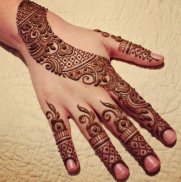

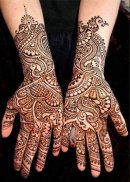
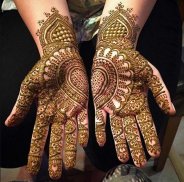
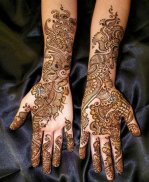
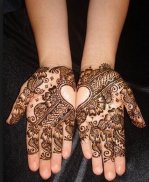
Bridal Mehndi Design

Описание Bridal Mehndi Design
On a broad basis, Mehndi designs are of two Kinds - Indian and Arabic. While Indian designs are more intricate, Arabic designs are bolder. Indian designs Consist of your children Which work fine Entire palm. Peacocks, flowers and mango juice are some of the common figures used in Indian designs. Indian bridal mehndi is much more intricate. Traditionally, the groom's name is on the bride's artistically hidden amidst the palm Elaborate designs. Also, pictures of marriage processions complete with bridal palanquin, where the horse groom, musical instruments and musicians playing traditional instruments are drawn on the hands. A bridal design Usually extends up to the elbow or even point higher.
Arabic mehndi designs are very different. Typically, there is not much intricacy in these designs, large outlines are drawn and the inner space is filled with lines and dots. Flowers and mango shaped designs are in the most commonly used. Quite in contrast to Indian designs, the Arabic waves do not cover the Entire hand. Some part of the hand is left blank. The beauty of these designs out commas Because of these blank spaces Which highlight the bold designs. Arabic designs are popularly applied for festivals and functions.
The most popular design of the recent times is the fusion between Indian and Arabic styles, known as Indo-Arabic mehndi. Bold Arabic figures are first drawn and the space inside is filled with Indian Elaborate designs. These hybrid designs are extremely eye catchy and unique. More and more people now prefer these designs since They look chic yet traditional and ethnic.
Culturally, application of mehndi is very significant. Apart from Being very visually appealing, the herb has strong medicinal properties. Being Strongly antiseptic in nature, mehndi protect against infections. This is the reason why mehndi is applied on the flanges of palms and feet as well as Grooms. Definitely, we would not want the bride and groom to fall sick prior to wedding. The same applies to festivals and functions.
In Andhra Pradesh, it is a custom to apply mehndi at least three times During the Hindu month of Shravan, Which coincides with the rainy season. Since water borne infections are high During this season, menhdi acts as a shield. Fresh leaves are ground and the paste is applied on palms and feet for men and women, adults and kids. Our ancestors Knew definitely a lot of healthy secrets!
























